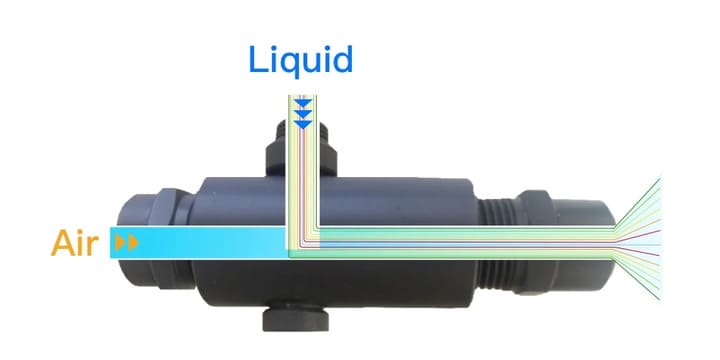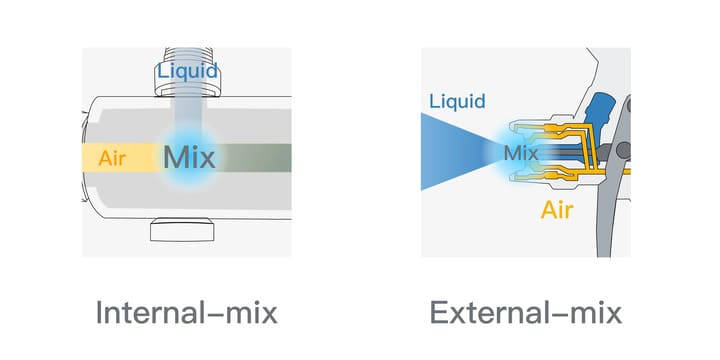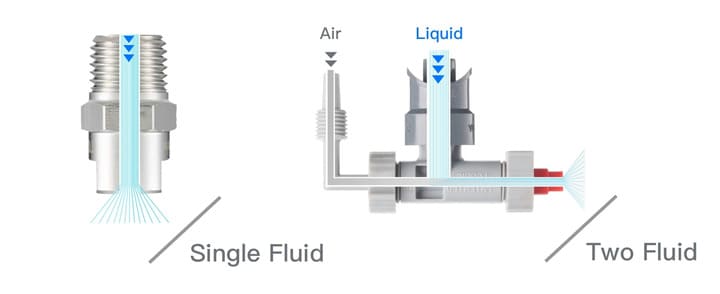In the industrial and manufacturing sector, the two-fluid nozzle stands out for propelling liquids into a fine mist with high-speed air, significantly enhancing spray efficiency. These nozzles, available in internal and external mixing types, offer tailored solutions for diverse applications. Internal mixing nozzles optimize the gas-liquid mixture inside, while external mixing combines them outside, catering to specific needs with their ability to produce varied spray patterns like fan-shaped, solid, and hollow cones. Despite the advantages of finer droplet generation, low-pressure operation, and uniform spray distribution, challenges such as design complexity, need for high-pressure gas, clogging risks, and higher costs persist. Yet, their critical use in precision-required processes like PCB etching and coating highlights their essential role in advancing manufacturing technology
1. What is two-fluid nozzle

The two-fluid nozzle functions by utilizing high-speed air to crush the liquid, thereby reducing the particle size of the liquid. This process enables the ejection of liquid with smaller particle sizes and higher flow rates.
2. Features of two-fluid nozzles
- Enhance liquid atomization by reducing particle size effectively.
- Expand the adjustable range of liquid flow by controlling gas pressure.
- Achieve high flow rate spraying and increase impact force significantly.
3. The principle of the two-fluid nozzle
The two-fluid nozzle revolutionizes spraying by turning liquid into finer particles with high-speed air, enhancing cleaning and chemical reaction efficiency on surfaces. For example, in the PCB etching process, it achieves more effective reactions and better coverage with smaller particles, requiring less chemical solution compared to traditional nozzles.
Yet, this innovation comes with considerations. The mix of gas and liquid, especially with chemicals, risks oxidation, potentially diminishing the solution's effectiveness more rapidly than expected. Moreover, the fine spray means some of the solution can escape with the exhaust gas, raising usage and necessitating exhaust treatment for environmental safety. In short, the two-fluid nozzle offers efficiency and precision in application but requires mindful operation to manage its drawbacks.
[1][2][3][4][5][6][7]
4. Mixing method of gas and liquid in two-fluid nozzle
( 1 ) Internal-mix two-fluid nozzles
Internal-mix two-fluid nozzles
The internal mixing two-fluid nozzle is a nozzle that enables the mixing of liquid and gas inside the nozzle. It is capable of producing extremely fine liquid particle sizes (with an average particle size below 50µm) and allows for control over the size and distribution of the liquid particles. This type of nozzle is commonly used in industries such as chemical, food, pharmaceutical, and printing, where high precision and efficiency are required.
( 2 ) External -mix two-fluid nozzles
External -mix two-fluid nozzles
The external mixing type two-fluid nozzle is a nozzle with non-clogging characteristics that allows the external mixing of liquid and gas. A common application of this type is the spray gun, which is a painting tool used to spray paint onto surfaces. The spray gun consists of a nozzle, paint cup, and compressed air machine. When the trigger is pressed, the paint mixes with the compressed air flow and is released in the form of fine spray mist.
( 3 ) The difference between Internal and external -mix two-fluid nozzles

Internal mixing and external mixing two-fluid nozzles are commonly used in various industries. These nozzles differ in how they mix gas and liquid. Internal-mixing nozzles blend the gas and liquid inside the nozzle and expel them through a single outlet. They offer easy operation, control, and the ability to achieve high spraying accuracy and uniformity. However, it's important to be mindful of potential clogging and cleaning issues since the mixing occurs within the nozzle.
On the other hand, external mixing nozzles mix the gas and liquid outside the nozzle and then spray them separately through different outlets. These nozzles are capable of delivering higher flow rates and covering a larger spray area, making them suitable for applications that involve coating with larger particles. However, one should be cautious about preventing air bubbles and ensuring spray uniformity when using external mixing nozzles.
Choosing the appropriate two-fluid nozzle type depends on the specific requirements of the application. Internal mixing nozzles are ideal when precision and uniformity are crucial, while external mixing nozzles are more suitable for applications that demand a larger coverage area and higher flow rates. It is essential to perform regular cleaning and maintenance of the nozzles to ensure optimal performance and prolong their lifespan.
[8]
5. The spray pattern of two-fluid nozzles

Two-fluid nozzles offer different spray shapes, including fan-shaped, solid cone, and hollow cone patterns. Typically, these nozzles are designed to produce a solid cone spray with uniform distribution and fine atomization. However, with the appropriate nozzle structure design, they can also generate fan-shaped and hollow-conical sprays.
It is important to note that two-fluid spraying is influenced by the surrounding environment, particularly due to the small size of the spray particles. As a result, the spray shape may not be maintained when spraying at certain distances. Factors such as air movement, humidity, and other environmental conditions can impact the trajectory and dispersion of the spray. Therefore, it is crucial to consider the specific environmental factors when utilizing two-fluid nozzles and adjust the spraying parameters accordingly to achieve the desired spray shape and coverage.
6. Identifying One-Fluid and Two-Fluid Nozzles

The main difference between a single-fluid nozzle and a two-fluid nozzle lies in their internal structure. A single-fluid nozzle has only one passage, while a two-fluid nozzle has two separate passages for gas and liquid. This difference affects their functionality and applications. Due to the need for air and liquid sealing, two-fluid nozzles are often designed with multiple components, which results in higher costs compared to single-fluid nozzles.
The main difference between a single-fluid nozzle and a two-fluid nozzle lies in their internal structure. A single-fluid nozzle has only one passage, while a two-fluid nozzle has two separate passages for gas and liquid. This difference affects their functionality and applications. Due to the need for air and liquid sealing, two-fluid nozzles are often designed with multiple components, which results in higher costs compared to single-fluid nozzles.
[9]
7. Advantages of two-fluid nozzles
- It is capable of generating a fine spray with smaller particle sizes (average size below 50µm) compared to a single fluid nozzle, and can operate at low pressures (0.1~0.3MPa).
- Ensures consistent and even distribution of the spray.
[10]
8. Disadvantages of two-fluid nozzles
- Intricate design
- Demands high-pressure gas
- Prone to clogging
- Requires precise machining
- Costly
- Due to the fine particle size of the sprayed liquid, it can easily lead to vaporization, resulting in the surrounding air becoming saturated with particles. When spraying corrosive liquids, complete isolation of the space is necessary, and increased liquid consumption is inevitable due to the vaporization process.
9. Applications of two-fluid nozzles
( 1 ) Two fluid etching
In wet PCB manufacturing, for etching narrow traces under 25μm, two-fluid nozzles are used to deliver chemical solutions into tiny gaps. These nozzles utilize high-speed air to create smaller droplets with higher flow velocity, ensuring uniform and efficient spraying. Thus, two-fluid nozzles are preferred for specific PCB processes.
( 2 ) Enhancing Exhaust Gas Treatment with Two-Fluid Nozzles
With the advantage of small droplet size, two-fluid nozzles are widely employed in the treatment of exhaust gases, particularly for addressing the issue of PM2.5 particles.

( 3 ) Cleaning Applications of Two-Fluid Nozzles
In cleaning applications, the use of high-pressure equipment can be costly. To address this, two-fluid nozzles are often employed due to their ability to achieve high spray velocities without the need for high pressure. An example is the application of two-fluid nozzles in the printing industry for cleaning ink in screen cleaning machines.
( 4 ) Other Applications of Two-Fluid Nozzles
These versatile nozzles find applications in smoke control, paint application, humidification, lubrication, gas cooling/conditioning, and atomization.
[11][12][13]